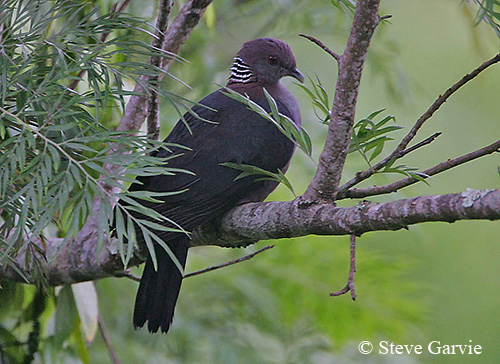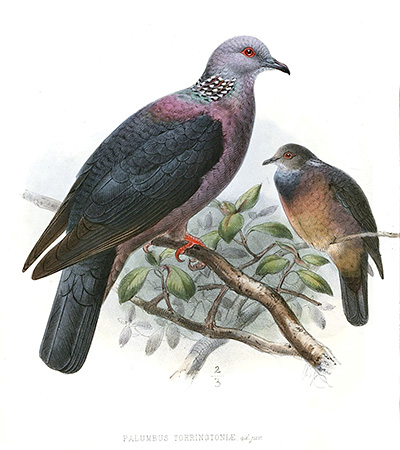
PROTECTION / THREATS / STATUS:
The Sri Lanka Wood Pigeon is affected by habitat loss caused by clearance and degradation of forests, especially in the wet zone.
Conversion for agriculture, tree plantations, human settlements, gem mining and fires are the main threats for the habitat, and involve the reduction of the main food resources of this species.
Even some protected forests continue to be degraded and suffer fragmentation.
The size of the population is roughly estimated to number 3,750 - 14,999 individuals.
It is suspected to be declining and becomes very fragmented. The species is now uncommon in the central mountains.
The Sri Lanka Wood Pigeon is currently listed as Vulnerable.
Fr: Pigeon de Ceylan
Ang: Sri Lanka Wood Pigeon - Ceylon Wood-Pigeon
All: Ceylontaube
Esp: Paloma de Ceilán
Ita: Colombaccio di Sri Lanka
Nd: Ceylonhoutduif
Sd: ceylonduva
Photographer:
Steve Garvie
RAINBIRDER Photo galleries
Illustrator:
John Gerrard Keulemans (1842–1912)
Illustration’s origin: A History of the Birds of Ceylon Volume 2.
https://archive.org/stream/historyofbirdsof02legg#page/n69/mode/1up
Text by Nicole Bouglouan
Sources:
HANDBOOK OF THE BIRDS OF THE WORLD vol 4 by Josep del Hoyo-Andrew Elliott-Jordi Sargatal - Lynx Edicions - ISBN: 8487334229
PIGEONS AND DOVES by David Gibbs, Eustace Barnes and John Cox - Pica Press Sussex - ISBN: 1873403607
Bird Watching Tour in Sri Lanka
Wikipedia, the free encyclopaedia
Sri Lanka Wood Pigeon
Columba torringtoniae
Columbiformes Order – Columbidae Family
INTRODUCTION:
The Sri Lanka Wood Pigeon is endemic to the hills of Sri Lanka and a resident breeder. It frequents moist deciduous montane forest, usually above 1,000 metres of elevation.
This arboreal Columbidae species is frugivorous and feeds on fruits and berries found in trees and shrubs.
The Sri Lanka Wood Pigeon nests in a typical flimsy twig structure placed in tree or shrub. This species lays a single white egg.
This handsome pigeon is usually shy and lives in pairs or in small groups.
The Sri Lanka Wood Pigeon is threatened by degradation of the habitat caused by extensive clearance of forests, involving the reduction of its favourite food resources.
The species is becoming uncommon and the population is declining. It is currently listed as Vulnerable.
DESCRIPTION OF THE BIRD:
Biometrics:
Length: 36 cm
The Sri Lanka Wood Pigeon has blackish/slate upperparts on lower mantle, scapulars, wing-coverts, back and rump. The upper mantle is glossy purple. The flight-feathers are dark brown. The uppertail-coverts and the broad tail are blackish.
On the underparts, chin and throat are greyish-white, shading into the purplish-grey breast. The belly is pinkish-buff whereas the undertail-coverts are buffy-grey. The underwing is blackish with dark brown flight-feathers.

The head is purplish-grey with some green and purple gloss on crown and nape. The black hindneck shows stiffened and aligned feathers with bright, white tips, forming a conspicuous, black-and-white chequered collar.
The bill is dark grey with paler bluish tip.
The eyes are pinkish to pale red, surrounded by bare, dull pink eyering.
The legs are pinkish but toes and soles of the feet are redder.
The female may appear duller than the male. Head and breast have little or no grey tinge. Both breast and lower part of the hindneck show coppery gloss on the purple feathers.
The juvenile is duller and browner than adults. The head is dark grey with very indistinct, mostly buffy-grey and black collar.
The rest of upperparts is dull blackish-brown with darker flight-feathers.
On the underparts, the throat is creamy-white/greyish-buff, and the breast is dark brownish-grey with narrow, rufous fringes. The belly is rusty-buff whereas the undertail-coverts are pale buff and show a scaly pattern formed by the darker buff feather’s tips. Both undertail and underwing are blackish-brown.
The bill shows reduced pale tip.
RANGE:
The Sri Lanka Wood Pigeon is endemic to Sri Lanka where it is mainly found in the centre of the island, in the hill country.
HABITAT:
The Sri Lanka Wood Pigeon prefers the damp, evergreen woodlands and the moist deciduous montane forests. While wandering into the rainforests, it may be found in the wet zone around 300 metres, but it breeds above 1,000 metres of elevation.
For a short time, the species seems to be adapting progressively to semi-natural habitats, except the plantations.
CALLS AND SONGS: SOUNDS BY XENO-CANTO
The Sri Lanka Wood Pigeon is usually silent outside of breeding season.
However, during this period, it gives a deep, almost owl-like “hoo” call, probably used as advertising call.
This call is given at intervals “hoo…hoo…hoo…” but it also produces more quavering hoots described as “whu-hu-hoo”.

BEHAVIOUR IN THE WILD:
The Sri Lanka Wood Pigeon is arboreal and frugivorous. It takes the food, usually fruits, berries and buds, from branches of trees and shrubs, and especially the fruits of the wild cinnamon which are its favourite food.
It may wander long distances while searching for fruiting trees.
It is more frequently seen in pairs or in small groups.
The courtship behaviour is unknown. However, in the family Columbidae, the male performs courtship displays around and close to the female. We can suggest that the typical bowing displays enhance the conspicuous nape’s chequered collar, well exposed towards the female through adapted postures.
The nest is a typical flimsy twig structure placed in tree or shrub. Both parents probably share the nesting duties.
The flight action is typical of these birds, with quick wingbeats interspersed with occasional sharp flicks of the wings.
The flight is strong and fast.
REPRODUCTION OF THIS SPECIES:
The breeding season takes place from February to November, with the nesting period mainly in October. The species seems to have a prolonged breeding season with a peak of activity in October.
The nest is built in tree or shrub, a flimsy twig structure within its evergreen woodland habitat.
The female lays a single white egg. Both adults probably share both incubation and chick-feeding.
No more information.

John Gerrard Keulemans
(1842–1912)